- Why Do Ficus Benjamin Leaves Fall Off?
- Natural Leaf Drop
- Lack of Light
- Symptoms of Lack of Light
- Solutions
- Overwatering
- Underwatering
- Temperature Fluctuations
- Pest Infestation
- Nutrient Deficiency
- Diseases and Fungal Infections
- 1. Leaf Spot Disease
- 2. Root Rot
- 3. Powdery Mildew
- 4. Anthracnose
- Q&A:
- Why do Ficus Benjamin leaves turn yellow and fall off?
- How can I prevent my Ficus Benjamin leaves from falling off?
- What should I do if I notice my Ficus Benjamin losing leaves?
- Can overwatering cause Ficus Benjamin leaves to fall off?
- Do temperature extremes affect Ficus Benjamin leaves?
- What are the signs of a pest infestation on Ficus Benjamin?
- How can I treat a pest infestation on my Ficus Benjamin?
- Video: Chlorosis! How to Treat Yellowing Foliage // Garden Answer
As we continue our exploration of the common causes of Ficus Benjamin leaves falling off, it is important to understand that this popular indoor plant requires specific care in order to thrive. In this article, we will delve into some additional factors that can lead to leaf loss and discuss potential solutions to these issues.
One common cause of leaf drop in Ficus Benjamin plants is inconsistent watering. Overwatering or underwatering can both have detrimental effects on the health of the plant. When the soil is too wet, the roots can become waterlogged and suffocate, leading to leaf loss. On the other hand, if the plant does not receive enough water, the leaves may dry out and fall off. To ensure proper hydration, it is essential to water the plant when the top inch of soil feels dry, being careful not to soak the soil too much or let it dry out completely.
Another factor that can contribute to leaf drop in Ficus Benjamin plants is improper lighting. These plants thrive in bright, indirect light, but direct sunlight can scorch the leaves and cause them to fall off. Similarly, if the plant is kept in an area with insufficient light, it may become weak and drop its leaves. To provide the optimal amount of light, place the plant near a north or east-facing window where it will receive bright, indirect sunlight for several hours each day.
In addition to watering and lighting issues, Ficus Benjamin plants can also be susceptible to pests, such as spider mites and aphids, which can cause leaf loss. These pests feed on the plant’s leaves, sucking out the sap and causing them to wither and drop off. Regularly inspect the plant for any signs of infestation, such as webbing or small insects, and treat the plant with organic insecticidal soap or neem oil to eliminate the pests.
By understanding these common causes of Ficus Benjamin leaf drop and implementing the appropriate solutions, you can help ensure the health and vitality of your indoor plant. With proper watering, lighting, and pest control, you can enjoy the beauty of your Ficus Benjamin with its lush, green foliage.
Why Do Ficus Benjamin Leaves Fall Off?
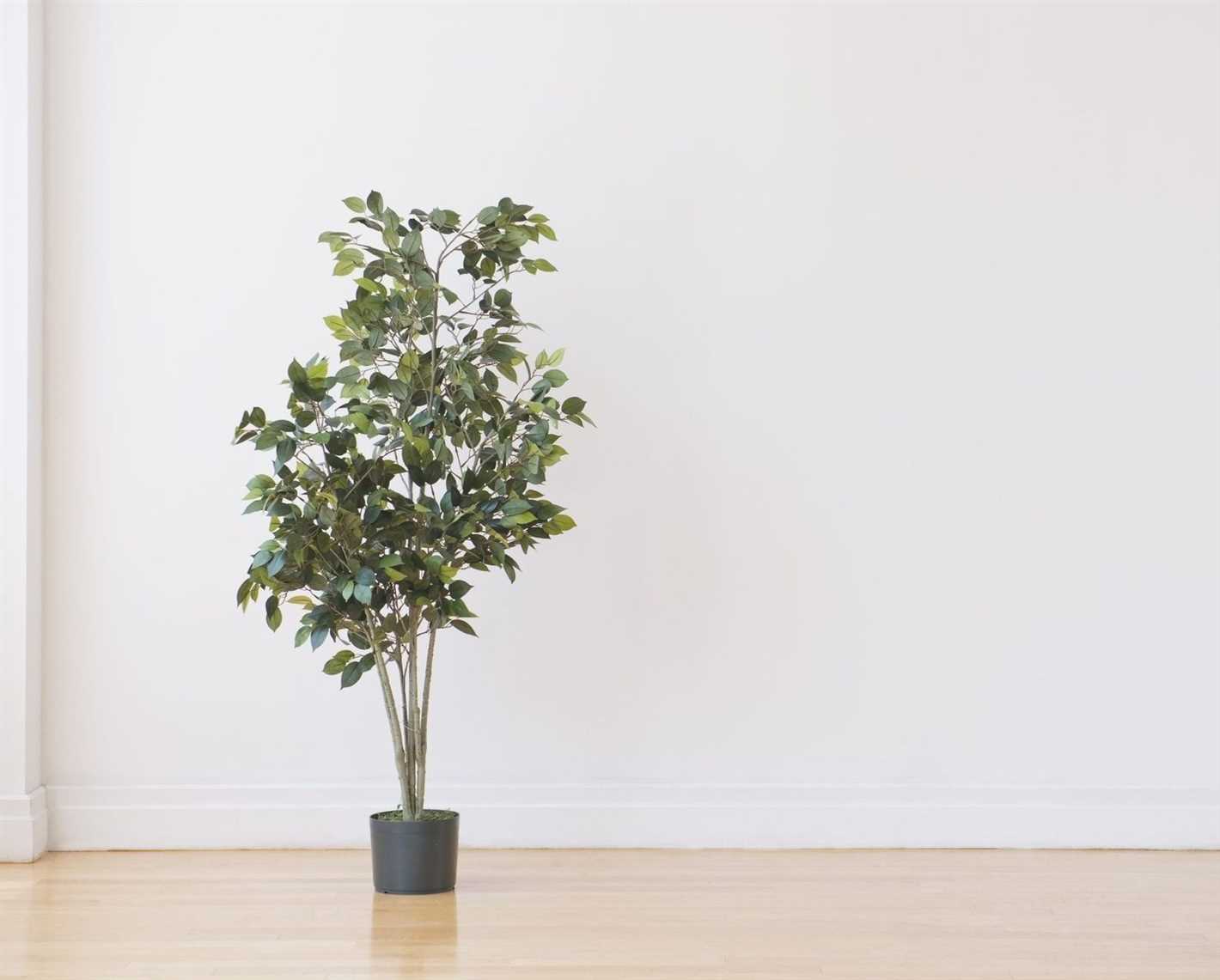
Ficus Benjamin, also known as the weeping fig, is a popular houseplant known for its beautiful foliage. However, one common problem that many Ficus Benjamin owners face is the leaves falling off.
There are several reasons why Ficus Benjamin leaves may fall off:
- Overwatering: One of the most common causes of leaf drop in Ficus Benjamin is overwatering. When the plant is overwatered, the roots become waterlogged, leading to root rot. This affects the plant’s ability to absorb water and nutrients, causing the leaves to turn yellow and fall off.
- Underwatering: On the other hand, underwatering can also cause leaves to drop. When the plant is not receiving enough water, it goes into survival mode and starts shedding leaves to conserve water. The leaves may turn brown and crispy before falling off.
- Lack of humidity: Ficus Benjamin is native to tropical regions and thrives in high humidity. Dry indoor environments can cause the leaves to dry out and drop. Using a humidifier or placing a tray of water near the plant can help increase humidity.
- Low light: Ficus Benjamin requires bright, indirect light to thrive. If it is not getting enough light, the leaves may turn yellow and drop. Moving the plant to a brighter location or providing artificial light can help prevent leaf drop.
- Stress: Stress factors such as sudden temperature changes, drafts, or being moved to a new location can cause Ficus Benjamin leaves to fall off. It is important to acclimate the plant gradually to new conditions to minimize stress.
To prevent Ficus Benjamin leaves from falling off, it is important to provide the plant with the right amount of water, humidity, light, and temperature. Regularly check the soil moisture before watering and adjust watering frequency accordingly. Maintain a humid environment by misting the leaves or using a pebble tray. Place the plant in a bright location, away from drafts or extreme temperature changes. Taking these steps will help keep your Ficus Benjamin healthy and avoid leaf drop.
Natural Leaf Drop
In some cases, the dropping of leaves from a Ficus Benjamin plant is a completely normal and natural process. Just like other plants, the Ficus Benjamin goes through cycles of growth and shedding leaves. These cycles can be influenced by seasonal changes, changes in light, temperature, and humidity levels, as well as the overall health of the plant.
During periods of stress or adjustment, the Ficus Benjamin may shed some of its leaves as a way to conserve energy and redirect resources to other parts of the plant. This is especially common when the plant is moved to a new location or when there is a change in its environment.
Additionally, older leaves on the Ficus Benjamin may naturally turn yellow and fall off as part of the plant’s growth and renewal process. This is usually nothing to be concerned about, as long as new leaves continue to grow and the plant remains healthy overall.
If the Ficus Benjamin is experiencing natural leaf drop, there is usually no need for intervention. However, it is still important to provide proper care and ensure that the plant’s basic needs are being met. This includes providing adequate sunlight, watering the plant properly, and maintaining a suitable temperature and humidity level.
Lack of Light
One common reason why Ficus Benjamin leaves may fall off is due to a lack of light. This plant thrives in bright, indirect light, and insufficient light can lead to leaf drop.
When a Ficus Benjamin doesn’t receive enough light, it struggles to produce energy through photosynthesis. As a result, the plant may shed its leaves in order to conserve energy and resources.
Symptoms of Lack of Light
- Yellowing or browning of leaves
- Leaf drop
- Stunted growth
- Long, leggy stems
Solutions
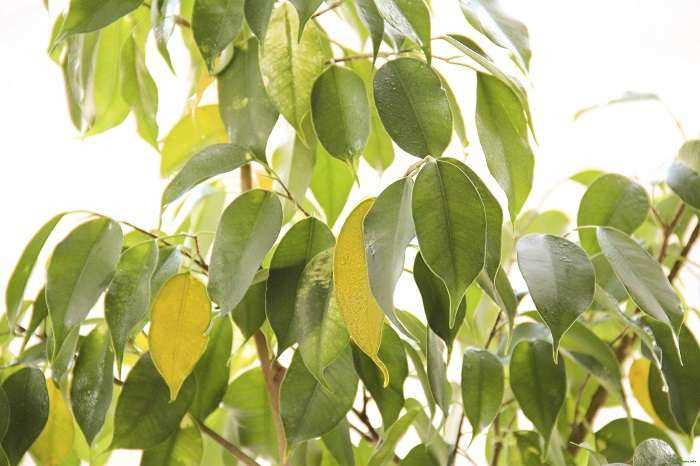
To prevent leaf drop due to a lack of light, you can try the following solutions:
- Move the plant to a brighter location: Ficus Benjamins need bright, indirect light. Place the plant near a window where it can receive ample sunlight, but avoid placing it in direct sunlight as this can scorch the leaves.
- Rotate the plant: If your Ficus Benjamin is not receiving light evenly, rotate it every few weeks to ensure all sides of the plant receive adequate light.
- Supplement with artificial light: If natural light is insufficient, you can supplement with artificial light. Use grow lights specifically designed for plants and position them above the plant to mimic the intensity and spectrum of natural sunlight.
- Prune overcrowded branches: If the Ficus Benjamin has dense foliage, it may be blocking light from reaching lower leaves. Prune overcrowded branches to allow better light penetration throughout the plant.
- Consider the placement: If your Ficus Benjamin is placed in a room with low light conditions, consider moving it to a more suitable location where it can thrive.
By addressing the lack of light issue, you can help your Ficus Benjamin regain its vitality and reduce the chances of leaf drop.
Overwatering
Overwatering is one of the most common problems that cause Ficus Benjamin leaves to fall off. This happens when the plant is consistently given more water than it needs, causing the roots to become waterlogged and suffocated.
Here are some signs that your Ficus Benjamin may be suffering from overwatering:
- Yellowing or browning of the leaves
- Drooping or wilting foliage
- The soil feels constantly damp or soggy
- Root rot or a foul smell coming from the soil
To solve the overwatering issue and prevent further leaf drop, take the following steps:
- Assess the soil moisture: Check the moisture level of the soil by sticking your finger about an inch deep. If it feels wet, it’s a sign that the plant has been overwatered.
- Adjust the watering schedule: Allow the soil to dry out partially between waterings. Only water the plant when the top inch of the soil feels dry to the touch.
- Improve drainage: Make sure the pot has drainage holes and use well-draining soil. If the soil is heavy and compacted, consider repotting the plant in a mixture of peat moss, perlite, and coarse sand to improve drainage.
- Remove excess water: If you notice standing water in the saucer, remove it to prevent the roots from sitting in water.
- Prune affected leaves: Trim any yellow, brown, or mushy leaves to promote new growth and prevent the spread of disease.
By addressing the overwatering issue and adjusting your care routine, you can help your Ficus Benjamin recover and prevent further leaf loss.
Underwatering
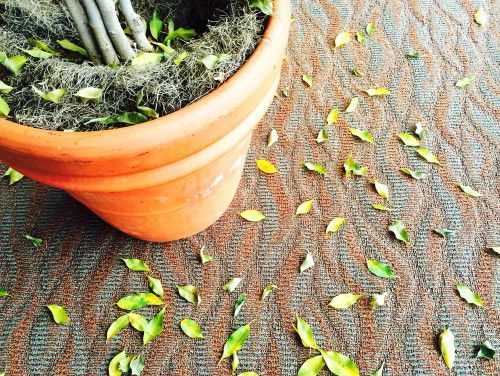
Underwatering is one of the main reasons why Ficus Benjamin leaves may fall off. When a Ficus Benjamin plant is not getting enough water, it can result in the plant becoming dehydrated and stressed. This can lead to the leaves turning yellow, wilting, and eventually falling off.
If you notice that the top layer of soil in your Ficus Benjamin’s pot is dry to the touch, it is a sign that the plant is not getting enough water. Underwatering can be caused by various factors, including forgetting to water the plant, not watering it thoroughly, or having improper drainage in the pot.
To address underwatering, it is important to establish a regular watering routine for your Ficus Benjamin. The frequency of watering will depend on factors such as the size of the plant, the pot size, and the environmental conditions. However, as a general rule, it is recommended to water the Ficus Benjamin when the top inch of soil feels dry.
When watering, ensure that you thoroughly soak the soil until water drains out of the pot’s bottom. This helps to ensure that the entire root system receives moisture. Avoid letting the plant sit in standing water, as this can lead to root rot and further stress the plant.
In addition to regular watering, it is also important to provide proper drainage for your Ficus Benjamin. This can be achieved by ensuring that the pot has drainage holes and using well-draining soil. Excess moisture trapped in the pot can lead to root rot and increase the risk of underwatering.
If your Ficus Benjamin is already experiencing leaf loss due to underwatering, you can help the plant recover by adjusting your watering routine and providing it with proper care. Monitor the soil moisture regularly and water the plant as needed, making sure to avoid both overwatering and underwatering.
Remember that each plant’s watering needs can vary, so it is important to observe your Ficus Benjamin and adjust your care routine accordingly. By properly watering your Ficus Benjamin, you can help prevent leaf loss and promote healthy growth.
Temperature Fluctuations
Temperature fluctuations can also cause the leaves of a Ficus Benjamin to fall off. This plant prefers a stable and consistent temperature range.
Extreme temperature changes can be stressful for the plant and can lead to leaf drop. Cold drafts, such as those from open windows or air conditioning vents, can be particularly damaging to the Ficus Benjamin.
To prevent leaf drop due to temperature fluctuations, it is important to keep the plant in a stable environment. Avoid placing it near windows or air vents that can expose it to cold drafts. Additionally, try to maintain a relatively consistent temperature in the room where the plant is located.
If you live in a region with extreme temperature fluctuations, you may need to consider relocating your Ficus Benjamin to a more suitable location or use insulation to protect it from temperature changes.
Pest Infestation
One common cause of Ficus Benjamin leaves falling off is a pest infestation. Pests such as aphids, mealybugs, scale insects, and spider mites can all damage the leaves and cause them to drop. These pests feed on the sap of the leaves, weakening them and causing them to yellow and eventually fall off.
Here are some common signs of pest infestation on Ficus Benjamin:
- Yellowing or discolored leaves
- Wilted or curled leaves
- Sticky or shiny leaves
- Presence of small insects or webbing on the leaves
If you notice any of these signs, it is important to take action quickly to prevent further damage to your Ficus Benjamin plant.
Here are some steps you can take to treat a pest infestation:
- Inspect the plant: Carefully examine the leaves, stems, and undersides of the leaves to identify any pests or signs of infestation.
- Remove pests: If you spot any insects, gently remove them from the plant using a cotton swab or a cloth soaked in soapy water. You can also use a small brush to remove scale insects or mealybugs.
- Prune affected areas: If the infestation is severe, prune the affected leaves or stems to prevent the pests from spreading to the rest of the plant.
- Apply insecticidal soap: Spray your Ficus Benjamin plant with insecticidal soap, following the instructions on the product label. This will help to kill any remaining pests.
- Maintain proper care: After treating the infestation, make sure to provide your Ficus Benjamin with proper care, including regular watering, appropriate lighting, and adequate airflow. This will help the plant recover and prevent future infestations.
Prevention is key:
To prevent pest infestations in the future, it is important to maintain a healthy environment for your Ficus Benjamin plant. Here are some tips to keep in mind:
- Regularly inspect your plant for signs of pests.
- Keep your plant clean by wiping the leaves with a damp cloth or sponge.
- Avoid overwatering, as this can create a favorable environment for pests.
- Monitor the humidity levels around your plant, as high humidity can attract pests.
- Consider using natural pest repellents, such as neem oil or insecticidal soap, as a preventive measure.
By being proactive and taking steps to prevent and treat pest infestations, you can help keep your Ficus Benjamin healthy and free from leaf drop.
Nutrient Deficiency
One of the common reasons for Ficus Benjamin leaves falling off is nutrient deficiency. When the plant does not receive adequate nutrients, its leaves tend to turn yellow and eventually drop. Here are some common nutrient deficiencies that can cause leaf drop:
- Nitrogen deficiency: Lack of nitrogen can result in pale green or yellow leaves. Fertilizing the plant with a nitrogen-rich fertilizer can help address this issue.
- Potassium deficiency: Insufficient potassium in the soil can lead to brown or yellow edges on the leaves. Adding potassium-rich fertilizer can help mitigate this deficiency.
- Phosphorus deficiency: When there is a lack of phosphorus, the leaves may appear dimpled or pitted. Applying a phosphorus-rich fertilizer can help overcome this deficiency.
- Magnesium deficiency: Insufficient magnesium can cause interveinal chlorosis, where the veins of the leaves remain green while the rest of the leaf turns yellow. Adding magnesium sulfate or Epsom salt to the soil can help resolve this deficiency.
- Iron deficiency: Inadequate iron can cause the leaves to turn yellow, especially between the veins. Applying iron chelates or iron sulfate can help address this deficiency.
To prevent nutrient deficiencies, it is important to provide the Ficus Benjamin with a balanced fertilizer that contains a mix of essential nutrients. Regularly feeding the plant according to the instructions on the fertilizer package can help ensure that it receives the necessary nutrients to maintain its health and vigor.
| Nutrient | Deficiency Symptoms |
|---|---|
| Nitrogen | Pale green or yellow leaves |
| Potassium | Brown or yellow edges on leaves |
| Phosphorus | Dimpled or pitted leaves |
| Magnesium | Interveinal chlorosis |
| Iron | Yellowing between leaf veins |
Diseases and Fungal Infections
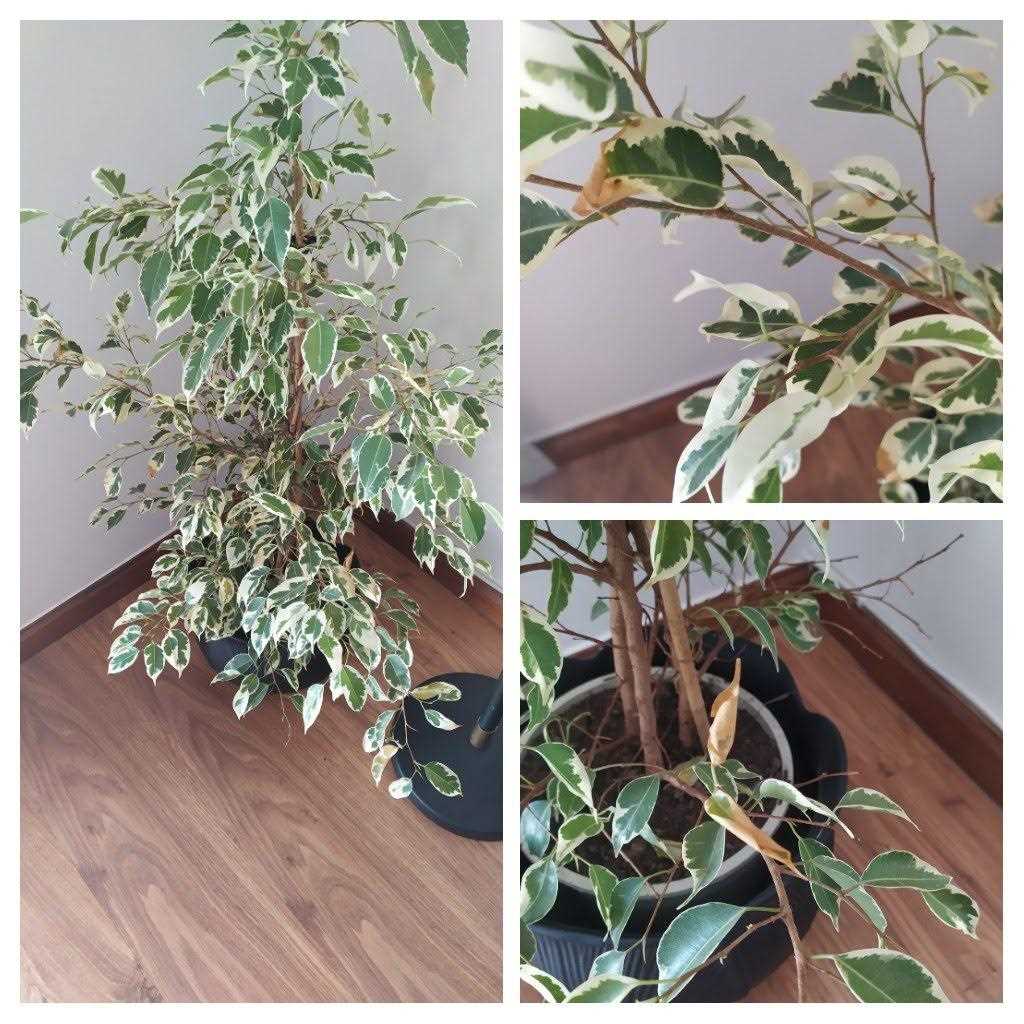
Ficus Benjamins are susceptible to various diseases and fungal infections, which can cause the leaves to fall off. These issues can be caused by several factors, including poor watering practices, inadequate light, and improper humidity levels. Here are some common diseases and fungal infections that can affect Ficus Benjamins:
1. Leaf Spot Disease
Leaf spot disease is a common fungal infection that affects the leaves of Ficus Benjamin plants. It is caused by various types of fungi, such as Cercospora, Mycosphaerella, and Alternaria. The symptoms of leaf spot disease include the appearance of dark spots or lesions on the leaves. As the disease progresses, the spots may grow larger and merge together, causing the affected leaves to turn yellow and fall off.
Prevention and Treatment:
- Ensure proper air circulation around the plant by avoiding overcrowding.
- Avoid overhead watering, as wet leaves can promote fungal growth.
- Remove and destroy any infected leaves or plant parts.
- Apply a fungicide recommended for leaf spot disease, following the manufacturer’s instructions carefully.
2. Root Rot
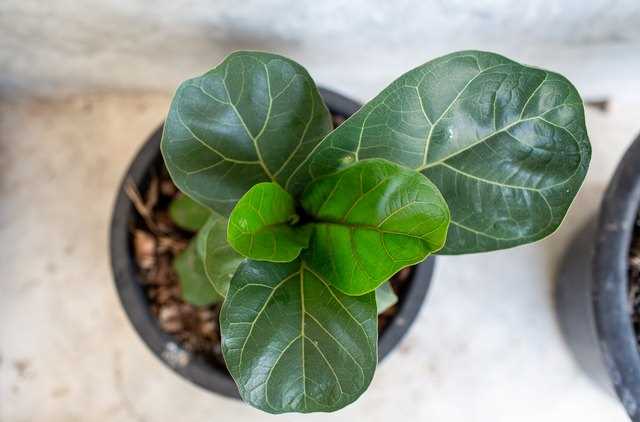
Root rot is a common disease caused by overwatering or poorly drained soil. Excessive moisture promotes the growth of fungi, such as Pythium and Phytophthora, which attack the roots of the plant. As the roots become damaged and decayed, the Ficus Benjamin may exhibit symptoms such as yellowing leaves, wilting, and leaf drop.
Prevention and Treatment:
- Make sure the pot has proper drainage holes to allow excess water to escape.
- Water the plant only when the top inch of soil feels dry.
- Avoid using a saucer to collect excess water, as this can lead to standing water and root rot.
- Consider repotting the plant in fresh, well-draining soil if root rot is severe.
3. Powdery Mildew
Powdery mildew is a fungal infection that appears as a white powdery coating on the leaves, stems, and other parts of the plant. It is caused by various fungi, such as Erysiphe or Oidium. The affected leaves may become distorted, turn yellow, and eventually drop off.
Prevention and Treatment:
- Provide proper air circulation around the plant.
- Avoid overcrowding and ensure adequate spacing between plants.
- Avoid watering the foliage, as this can create a moist environment favorable for powdery mildew.
- Treat powdery mildew with a fungicide labeled for this specific fungal infection, following the recommended application rates.
4. Anthracnose
Anthracnose is a fungal disease that affects many plants, including Ficus Benjamins. It typically appears as small, dark spots on the leaves, which may enlarge and turn brown or black. The affected leaves may eventually shrivel and fall off.
Prevention and Treatment:
- Prune and destroy any infected plant parts.
- Improve air circulation by spacing plants appropriately.
- Avoid over-watering and provide proper drainage.
- Apply a fungicide recommended for anthracnose, following the manufacturer’s instructions.
By understanding the common diseases and fungal infections that can affect Ficus Benjamins, you can take appropriate preventive measures and provide timely treatment to keep your plant healthy and leaf drop-free.
Q&A:
Why do Ficus Benjamin leaves turn yellow and fall off?
Yellowing and falling off of Ficus Benjamin leaves can be caused by various factors including overwatering, inadequate lighting, temperature extremes, and pest infestation. It is important to address the underlying cause to prevent further leaf loss and maintain the health of the plant.
How can I prevent my Ficus Benjamin leaves from falling off?
To prevent Ficus Benjamin leaves from falling off, ensure you provide the plant with the right amount of water, avoiding overwatering or underwatering. Place the plant in a location with adequate lighting, away from temperature extremes. Regularly inspect the plant for any signs of pests and take appropriate measures to control them.
What should I do if I notice my Ficus Benjamin losing leaves?
If you notice your Ficus Benjamin losing leaves, it is important to identify and address the underlying cause. Check the plant’s watering schedule and adjust it if necessary. Evaluate the lighting conditions and consider moving the plant to a more suitable location if needed. Inspect the plant for any signs of pests and treat them accordingly. Providing proper care and addressing the issue promptly can help prevent further leaf loss.
Can overwatering cause Ficus Benjamin leaves to fall off?
Yes, overwatering can cause Ficus Benjamin leaves to fall off. When the roots of the plant are constantly saturated with water, it can lead to root rot and the plant’s inability to take up necessary nutrients. As a result, the leaves may turn yellow and eventually fall off. Proper watering practices, allowing the soil to dry out between waterings, can help prevent overwatering and maintain the health of the plant.
Do temperature extremes affect Ficus Benjamin leaves?
Yes, temperature extremes can affect Ficus Benjamin leaves and cause them to fall off. Exposure to cold drafts or very hot temperatures can stress the plant, leading to leaf yellowing and dropping. It is important to place the plant in a location with a consistent temperature and protect it from drafts. Avoid placing the plant near heating or cooling vents, as well as windows that receive direct sunlight.
What are the signs of a pest infestation on Ficus Benjamin?
Signs of a pest infestation on Ficus Benjamin may include visible pests such as aphids, mealybugs, or spider mites on the leaves and stems. You may also notice the presence of sticky residue on the leaves or small holes in the foliage. Additionally, the leaves may appear distorted or discolored. Regularly inspecting the plant and treating any pest infestations promptly can help prevent leaf loss.
How can I treat a pest infestation on my Ficus Benjamin?
If you have a pest infestation on your Ficus Benjamin, there are several treatment options available. You can try removing the pests manually using a soft cloth or cotton swab dipped in a mild soap solution. Another option is to use organic insecticidal soap or horticultural oil, following the instructions on the product label. For severe infestations, it may be necessary to consult a professional or use stronger chemical pesticides, ensuring to follow the safety guidelines and precautions.
Video:
Chlorosis! How to Treat Yellowing Foliage // Garden Answer







